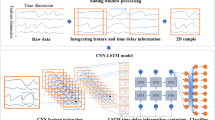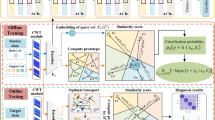Abstract
The harmonic reducer is an essential kinetic transmission component in the industrial robots. It is easy to be fatigued and resulted in physical malfunction after a long period of operation. Therefore, an accurate in-situ fault diagnosis for the harmonic reducers in an industrial robot is especially important. This paper proposes a fault diagnosis method based on deep learning for the harmonic reducer of industrial robots via consecutive time-domain vibration signals. Considering the sampling signals from industrial robots are long, narrow, and channel-independent, this method combined a 1-dimensional convolutional neural network with matrix kernels (1-D MCNN) adaptive model. By adjusting the size of the convolution kernels, it can concentrate on the contextual feature extraction of consecutive time-domain data while retaining the ability to process the multi-channel fusion data. The proposed method is examined on a physical industrial robot platform, which has achieved a prediction accuracy of 99%. Its performance is appeared to be superior in comparison to the traditional 2-dimensional CNN, deep sparse automatic encoding network (DSAE), multilayer perceptual network (MLP), and support vector machine (SVM).
Similar content being viewed by others
References
Hwang I, Kim S, Kim Y, et al. A survey of fault detection, isolation, and reconfiguration methods. IEEE Trans Contr Syst Technol, 2009, 18: 636–653
Abid A, Khan M T, Iqbal J. A review on fault detection and diagnosis techniques: Basics and beyond. Artif Intell Rev, 2021, 54: 3639–3664
Khalastchi E, Kalech M. On fault detection and diagnosis in robotic systems. ACM Comput Surv, 2018, 51: 1–24
McIntyre M L, Dixon W E, Dawson D M, et al. Fault identification for robot manipulators. IEEE Trans Robot, 2005, 21: 1028–1034
Xiao B, Yin S. An intelligent actuator fault reconstruction scheme for robotic manipulators. IEEE Trans Cybern, 2017, 48: 639–647
De Luca A, Ferrajoli L. A modified Newton-Euler method for dynamic computations in robot fault detection and control. In: Proceedings of the 2009 IEEE International Conference on Robotics and Automation. Kobe, 2009. 3359–3364
Yin S, Ding S X, Xie X, et al. A review on basic data-driven approaches for industrial process monitoring. IEEE Trans Ind Electron, 2014, 61: 6418–6428
Zhang D, Qian L, Mao B, et al. A data-driven design for fault detection of wind turbines using random forests and XGboost. IEEE Access, 2018, 6: 21020–21031
Gertler J, Cao J. PCA-based fault diagnosis in the presence of control and dynamics. AIChE J, 2004, 50: 388–402
Muradore R, Fiorini P. A PLS-based statistical approach for fault detection and isolation of robotic manipulators. IEEE Trans Ind Electron, 2011, 59: 3167–3175
Akerkar R, Sajja P. Knowledge-Based Systems. Sudbury: Jones & Bartlett Publishers, 2009
Feng Z, Zhou Z, Hu C, et al. Fault diagnosis based on belief rule base with considering attribute correlation. IEEE Access, 2017, 6: 2055–2067
Abid A, Khan M T, Ullah A, et al. Real time health monitoring of industrial machine using multiclass support vector machine. In: Proceedings of the 2nd International Conference on Control and Robotics Engineering (ICCRE). Bangkok, 2017. 77–81
Pettersson O. Execution monitoring in robotics: A survey. Robotics Autonomous Syst, 2005, 53: 73–88
Freyermuth B. Knowledge based incipient fault diagnosis of industrial robots. IFAC Proc Volumes, 1991, 24: 369–375
Sabry A H, Nordin F H, Sabry A H, et al. Fault detection and diagnosis of industrial robot based on power consumption modeling. IEEE Trans Ind Electron, 2019, 67: 7929–7940
Jaber A A, Bicker R. Industrial robot backlash fault diagnosis based on discrete wavelet transform and artificial neural network. Am J Mech Eng, 2016, 4: 21–31
Vallachira S, Orkisz M, Norrlof M, et al. Data-driven gearbox failure detection in industrial robots. IEEE Trans Ind Inf, 2019, 16: 193–201
Masoumi M, Alimohammadi H. An investigation into the vibration of harmonic drive systems. Front Mech Eng, 2013, 8: 409–419
Liu Y, Tan C, Zhao Y, et al. Nonlinear attributes modeling and analysis of harmonic drive manipulator joint. In: Proceedings of the 3rd International Conference on Control, Automation and Robotics (IC-CAR). Nagoya, 2017. 256–264
Jaber A A, Bicker R. Fault diagnosis of industrial robot gears based on discrete wavelet transform and artificial neural network. Insight, 2016, 58: 179–186
Guo L, Lei Y, Li N, et al. Deep convolution feature learning for health indicator construction of bearings. In: Proceedings of the Prognostics and System Health Management Conference (PHM-Harbin). Harbin, 2017. 1–6
Krizhevsky A, Sutskever I, Hinton G E. Imagenet classification with deep convolutional neural networks. Adv Neural Inf Process Syst, 2012, 25: 1097–1105
Jia F, Lei Y, Lin J, et al. Deep neural networks: A promising tool for fault characteristic mining and intelligent diagnosis of rotating machinery with massive data. Mech Syst Signal Process, 2016, 72–73: 303–315
Liu R, Yang B, Zio E, et al. Artificial intelligence for fault diagnosis of rotating machinery: A review. Mech Syst Signal Process, 2018, 108: 33–47
Chen Z, Mauricio A, Li W, et al. A deep learning method for bearing fault diagnosis based on cyclic spectral coherence and convolutional neural networks. Mech Syst Signal Process, 2020, 140: 106683
Jia F, Lei Y, Lu N, et al. Deep normalized convolutional neural network for imbalanced fault classification of machinery and its understanding via visualization. Mech Syst Signal Process, 2018, 110: 349–367
Ince T, Kiranyaz S, Eren L, et al. Real-time motor fault detection by 1-D convolutional neural networks. IEEE Trans Ind Electron, 2016, 63: 7067–7075
Lei Y, Yang B, Jiang X, et al. Applications of machine learning to machine fault diagnosis: A review and roadmap. Mech Syst Signal Process, 2020, 138: 106587
Cui X, Goel V, Kingsbury B. Data augmentation for deep neural network acoustic modeling. IEEE ACM Trans Audio Speech Lang Process, 2015, 23: 1469–1477
Chen L, Cao J, Wu K, et al. Application of generalized frequency response functions and improved convolutional neural network to fault diagnosis of heavy-duty industrial robot. Robot Comput Integr Manuf, 2022, 73: 102228
Wen L, Li X, Gao L, et al. A new convolutional neural network-based data-driven fault diagnosis method. IEEE Trans Ind Electron, 2017, 65: 5990–5998
Xu B, Wang N, Chen T, et al. Empirical evaluation of rectified activations in convolutional network. arXiv: 1505.00853, 2015
Liu R, Meng G, Yang B, et al. Dislocated time series convolutional neural architecture: An intelligent fault diagnosis approach for electric machine. IEEE Trans Ind Inf, 2016, 13: 1310–1320
Tang S, Shen C, Wang D, et al. Adaptive deep feature learning network with Nesterov momentum and its application to rotating machinery fault diagnosis. Neurocomputing, 2018, 305: 1–14
Li B, Chow M Y, Tipsuwan Y, et al. Neural-network-based motor rolling bearing fault diagnosis. IEEE Trans Ind Electron, 2000, 47: 1060–1069
Medvedev M, Kadhim A, Brosalin D. Development of the neural-based navigation system for a ground-based mobile robot. In: Proceedings of the 7th International Conference on Mechatronics and Robotics Engineering (ICMRE). Budapest, 2021. 35–40
Hong Y, Sun Z, Zou X, et al. Multi-joint industrial robot fault identification using deep sparse auto-encoder network with attitude data. In: Proceedings of the Prognostics and Health Management Conference (PHM-Besançon). Besancon, 2020. 176–179
Chen W Y, Xu J X, Panda S. Application of artificial intelligence techniques to the study of machine signatures. In: Proceedings of the International Conference on Electrical Machines. Marseille, 2012. 2390–2396
Author information
Authors and Affiliations
Corresponding author
Additional information
This work was supported by the Basic and Applied Basic Research Fund of Guangdong Province (Grant No. 2020B1515120010).
Rights and permissions
About this article
Cite this article
Zhou, X., Zhou, H., He, Y. et al. Harmonic reducer in-situ fault diagnosis for industrial robots based on deep learning. Sci. China Technol. Sci. 65, 2116–2126 (2022). https://doi.org/10.1007/s11431-022-2129-9
Received:
Accepted:
Published:
Issue Date:
DOI: https://doi.org/10.1007/s11431-022-2129-9




